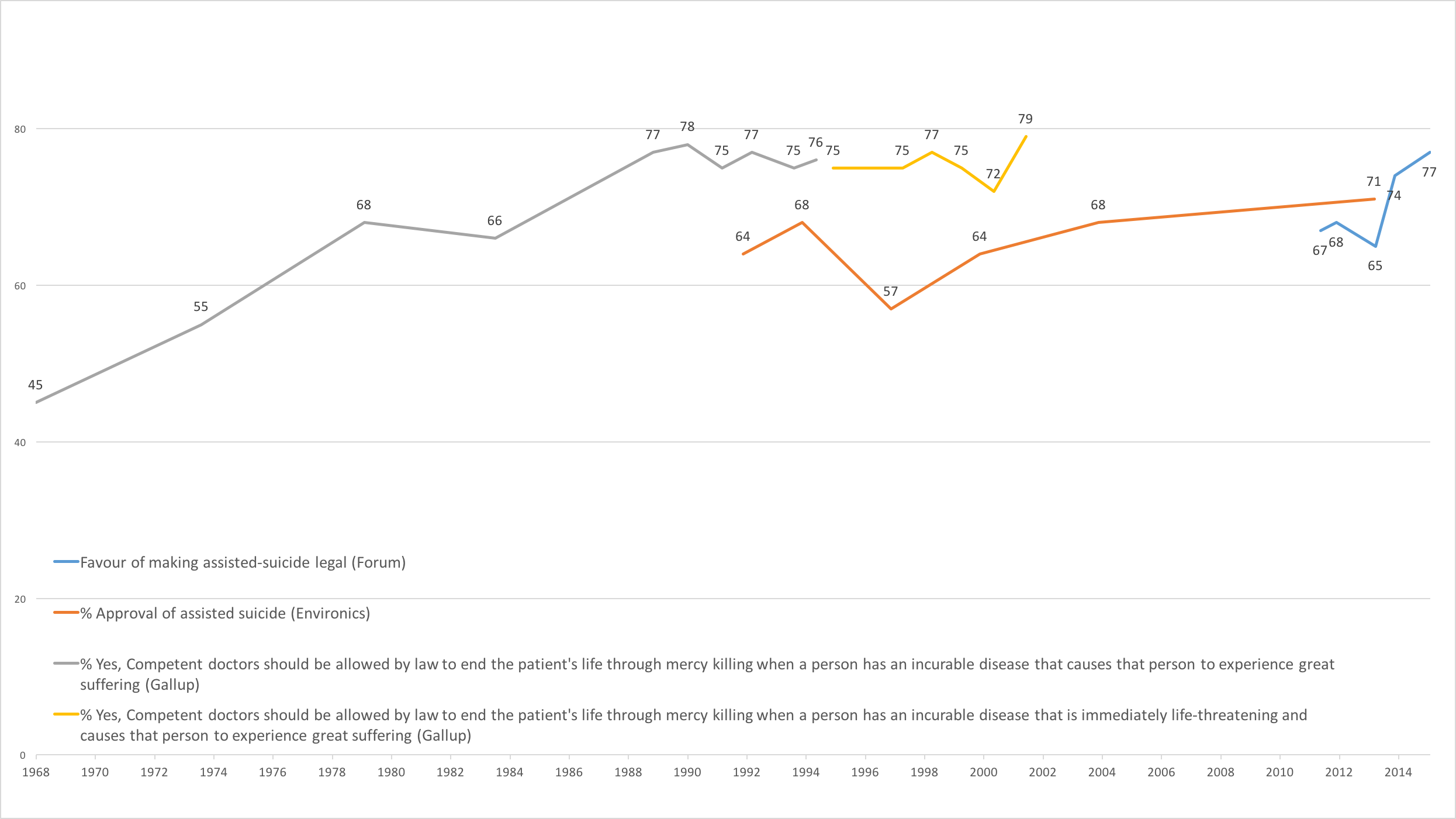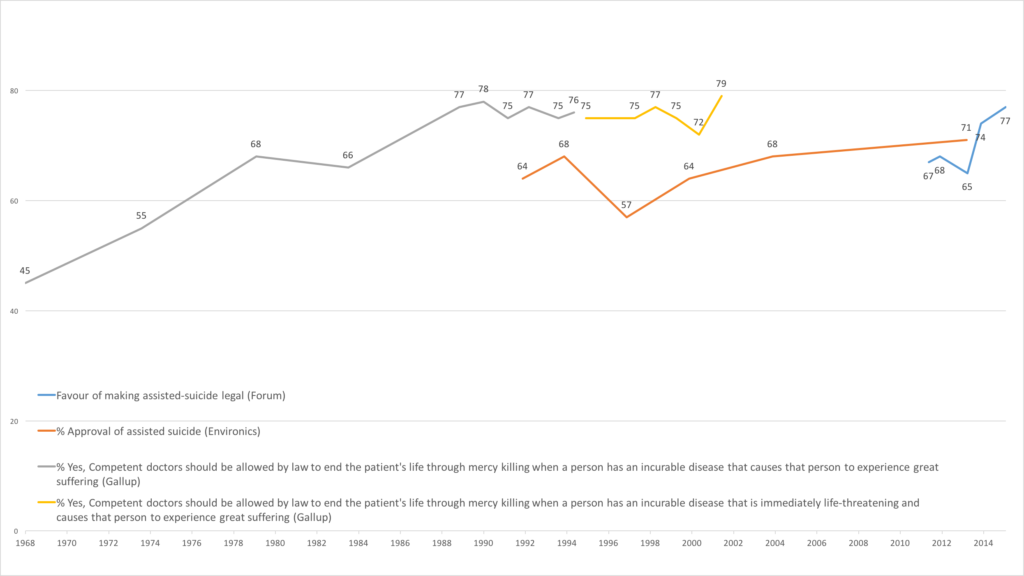One of the compelling and topical issues from a public opinion perspective at present is the question of assisted dying. There have been a significant number of polls in Canada over the past couple years reflecting the need for new legislation since the Supreme Court set aside the criminal treatment of assisted dying. While the current polls are interesting, it is useful to look back on the issue from an historical public opinion position.
Assisted dying, which was called other things at the time, has been the subject of relatively few Canadian public opinion polls but the overall trend is one of a dramatic increase in support through the 70s and early 80s after which polls continued to show a majority in favour of allowing it.
The available historical data
Although, the vernacular around the issue (from mercy killing, assisted suicide and euthanasia to assisted dying) has evolved over time and this is reflected in public opinion questions, the overall conclusion from a review of the historical evidence is that a significant majority has always supported allowing assisted dying going back to 1978.
Gallup
The longest trend data that is available is a single question asked by Gallup from 1968 to 2002. Clearly, a majority supports the assisted suicide position by 1968 and support grows into the 1990s after which it is fairly stable. Note that the graph shows two Gallup trend lines because there is break in the series when Gallup made a subtle change to the question to reinforce that the disease was immediately life- threatening.
“When a person has an incurable disease that is immediately life-threatening and causes that person to experience great suffering, do you, or do you not think that competent doctors should be allowed by law to end the patient’s life through mercy killing, if the patient has made a formal request in writing?” [1]
The question was asked across a range of survey modes including in-person and telephone and the question is not ideal. Three aspects of the wording are noteworthy.
- The question is long, demanding respondents process a lot of information;
- The question reduces this to a simple yes/ no question;
- In hindsight, referring to “mercy killing” even if it is qualified by the fact that the patient made the request infers that the person should want to end their life rather than being a personal decision.
Environics
Overlapping somewhat with the Gallup trend, is a question asked by Environics. Across the two decades, the proportion who approved the question varied from a low of 57% in 1997 to a high of 71% in 2013. While the last survey is also the high point, the trend is fairly stable on this question. In fact, the 1997 survey is anomalous in the sense that 20% offered a “depends” option so the share of disapprove did not increase in that year.
“Do you approve or disapprove of euthanasia – that is, allowing a terminally ill or severely disabled person to end their life?”
The question shares with the Gallup question a very simple scale – approve or disapprove – but it is a simpler construction in that it is uses fewer words and less conditions. Of course, this simple construction means that we cannot be sure how qualified the support is.
Environics also asked a parallel question on the same surveys that generated similiar results. In this question, respondents were asked “Do you think someone who assists in the suicide of a seriously ill patient should, or should not, be charged with a crime?”. Across the same period the proportion who said that they should be charged with a crime was highest in 2000 at 26% but also quite stable.
Forum
A Forum survey question, has the most recent trend information but it is also one that has been asked over the shortest time period. Across the 5 surveys there there is some evidence of rising support in the past five years with support reaching its highest level in August of last year. The rise is, of course, fairly small within the context of an overall positive view of physician-assisted dying observed in the poll and others in the past twenty years.
“Are you in favour or opposed to making physician-assisted suicide legal in Canada for the terminally ill?”
International Comparisons
An analysis of a single question asked in 12 European countries between 1981 and 1999 on the European Values Survey shows that acceptance of euthanasia increased in all countries, except Germany across the time period.[2] Cohen at al. (2006) find that the rise in acceptance can be attributed to changes in educational attainment, the secularization of society, the more permissive approach to individual freedom, and country-specific events.
Trend data in the U.S. also shows support for the idea of assisted dying. From 1947 to the 1970s there was an increase in support for allowing physician assisted suicide[3] with 69% taking the support position in 1996.[4] More recent 2013 American data reported by the Pew Research Center shows a divided American public; 47% approve of and 49% disapprove of allowing doctor assisted suicide for terminally ill patients.[5] The latter result reflects a trend toward less support over the past decade[6] and the importance of question wording as Gallup has found that support for assisting suicide is lower than for helping someone end their life.
Observations
When the Supreme Court made its decision, it brought the legal status in line with the broad public view of the issue. A strong majority of Canadians, in principle, have been in favour of assisted suicide for most of the last thirty years irrespective of the fact that at certain times the issue has been contested in courts (for a timeline of the issue visit: http://www.cbc.ca/news/health/timeline-assisted-suicide-in-canada-1.2946485). Canadians are not alone in become more positive about assisted dying as this is consistent with international public opinion but Canada is one of the more permissive.[7]
While Canadians support the principle, this is clearly an overreaching value perspective that offers very little insight into how the principle should be realized. For most of the past forty years, perhaps because there has been little prospect of its realization in policy, questions have focused on a very simplistic representation of the issue and thus, perhaps, encouraged respondents to express their top-of-mind support for personal liberty rather than fully explore the competing challenges and policy consequences of the issue.
[1] The underlined words were added in 1995.
[2] Cohen, Joachim, Isabelle Marcoux, Johan Bilsen, Patrick Deboosere, Gerrit van der Wal, Luc Deliens 2006. “Trends in acceptance of euthanasia among the general public in 12 European countries (1981–1999)” European Journal of Public Health, Vol. 16, No. 6, 663–669.
[3] Actual Gallup question, “When a person has a disease that cannot be cured, do you think doctors should be allowed by law to end the patient’s life by some painless means if the patient and his family request it?”
[4] Benson JM. The polls-trends—End-of-life issues. Public Opinion Quarterly 1999; 63:263–77.
[5] http://www.pewforum.org/2013/11/21/chapter-1-opinion-about-laws-on-doctor-assisted-suicide/
[6] http://www.gallup.com/poll/162815/support-euthanasia-hinges-described.aspx
[7] Ellen Verbakel and Eva Jaspers (2010) “A Comparative Study on Permissiveness Toward Euthanasia: Religiosity, Slippery Slope, Autonomy, and Death with Dignity” Public Opinion Quarterly 74 (1): 109-139.


